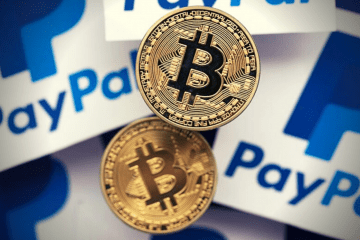Is Stablecoin the Next Big Thing in E-Commerce?
A few years ago, if you had heard that the U.S. government might mint its own digital currency, you might have dismissed the idea as starry-eyed futurism — or, less charitably, a joke. Digital currencies, such as Bitcoin, were the purview of speculators and coders, not stodgy central bankers. But this winter, the Federal Reserve announced that it’s investigating the possibility of issuing its own digital coin. Speaking at Stanford, Federal Reserve Governor Lael Brainard noted that the “potential for digitalization to deliver greater value and convenience at lower cost” has piqued the interest of the traditionally risk-averse institution.
For now, the Fed’s interest in digital currency might be most notable as a sign of how the world has changed — and where the winds are blowing. Because just as Paypal and eBay (or Alipay and Taobao, if you prefer) revolutionized how people shopped online and Amazon changed how people shop, full stop, digital payment services — powered by blockchain technology — could be the next great upheaval in global e-commerce growth. For that to come to pass, however, four conditions need to align: appropriate technology, consumer demand, corporate champions, and an amenable regulatory environment.
The question is how. For all the hype around blockchain — the open-source digital ledgers that many have argued will do everything from make cash obsolete to remake the global economy — it can sometimes seem like a solution looking for a problem. While it has found a place in niches such as supply chains and digital IDs, problems like price volatility and the need to comply with the existing regulatory framework have prevented mainstream adoption in currency. But now, one promising category of cryptocurrencies known as “stablecoins” seems poised to succeed where its predecessors failed. Uniquely positioned to act as a medium of exchange in e-commerce, stablecoins enhance both the efficiency and reach of e-commerce.
Finding the Right Application for Blockchain
As their name suggests, stablecoins distinguish themselves from their more popular but highly volatile cryptocurrecy brethren, such as Bitcoin, in their focus on price stability. In striving for stability from the start, stablecoins hope to avoid situations like the one experienced by Laszlo Hanyecz in 2010. Hanyecz was a U.S.-based software programmer who agreed to pay someone 10,000 Bitcoin for two Domino’s pizzas (a fair price at a time when Bitcoin was worth only a fraction of a penny). Today, this transaction would be worth almost $100 million. Hanyecz was proving a point — this was the first instance of a good being purchased with a cryptocurrency — but the now-legendary story has also become an allegory of the pitfalls of using a notoriously volatile tender for day-to-day purchases.
Stablecoins have adopted a variety of approaches to solve this price volatility problem. The highest profile attempt so far — and the most controversial — has been Facebook’s new, yet-to-be-released cryptocurrency project, Libra, which was supposed to be tied to a basket of short-term government securities and bank deposits in historically stable currencies such as U.S. dollars and Euros. Pushback from regulators and traditional financial institutions has induced Facebook to pull away from its original vision of a global currency that competed with monetary authorities. Although there is still a lot of uncertainty surrounding the project, it might look more like Venmo, with people sending dollars through Facebook.
Terra (where Nicholas works) is a new stablecoin that has been adopted by several online merchants across Southeast Asia. It’s less well-known in the U.S., but it’s an example of how stablecoins actually work in the wild — a blockchain currency with reliable value that normal people actually use. In contrast to Libra, it employs a form of automated monetary policy to keep its price stable, contracting the supply when prices are too low and expanding it when prices are too high. This is achieved using a second cryptocurrency, Luna, which acts as a monetary policy instrument and earns transaction fees as a form of reward. And while criticism of Libra has mainly been centered on how its governance mechanism is controlled by a few large corporations — the Switzerland-based Libra Association — Terra’s policy is coded directly on its blockchain and therefore is transparent and impervious to human interference.
The stability and transparency of Terra are important because they harness the potential of blockchain in a form that’s useful for everyday people. That, in turn, sets it up to challenge existing technologies. In the case of Terra, that means taking on credit cards.
Better Than a Credit Card
Enthusiasts often point to cryptocurrencies’ potential to enhance both the efficiency and reach of e-commerce. The existing financial system — while certainly functional — has its share of inefficiencies, including its reliance on middle men, which often come in the form of credit card providers that charge up to 3% per transaction. Blockchain technology allows payments to occur directly between buyers and sellers, circumventing the existing system and reducing costs for both merchants and consumers. Blockchain also allows for the automation of the transaction verification process, where most banks today still expend significant resources on expensive manual verification. In fact, Santander InnoVentures has estimated that “blockchain technologies could reduce banks’ infrastructural costs by $15-20 billion a year by 2022.” These advantages will bring faster settlement times and cheaper international transactions.
As shown by the Square’s staggering success in attracting small businesses with lower fees, stablecoins’ higher efficiency is likely to translate into wider reach. Merchants, who build those fees into their prices, might be more willing to offer their products online because of the lower fees. Similarly, customers might decide to keep balances in digital currencies and complete more transactions online without ever going back to fiat currency or feel the need for a credit card account. For the 25% of U.S. households that the FDIC has identified as unbanked or underbanked, lower fees and lack of barriers to entry could be transformative. Finally, the general mistrust in financial intermediaries that leads millennials to flee traditional banks for fintechs and challenger banks suggests they’d be willing crypto adopters.
These features could prove to be the edge that drives stablecoins into the financial mainstream. To understand the effects that they might have on the e-commerce ecosystem, we can use data from Terra, which has experienced explosive growth since launching in June 2019, growing at 35% month-over-month. It now has over 1 million users, who frequently use it for online purchases ranging from groceries to hotel bookings. Due to easy onboarding and lower fees, merchants have been the first to promote Terra over alternative payment options, e.g. credit cards, thereby facilitating its rapid adoption. Terra’s growth has been driven by a significant reduction in the adoption of other payment systems, including credit cards. This suggests what E-commerce 2.0 might look like in the western world as well.
If stablecoins are going to become mainstream, however, they need corporate champions as well as innovative outsiders, and they’re starting to win influential insiders over. Facebook’s debacle in launching Libra has been instrumental in bringing attention to this opportunity and has accelerated similar developments elsewhere. Financial institutions, including JP Morgan, have recognized the need for a digital currency for payments. Jack Dorsey’s Square has recently won a patent for a network allowing consumers to pay with cryptocurrency and merchants to receive the full value in U.S. dollars, eliminating any concerns about crypto volatility. Finally, the whole financial ecosystem is evolving —challenger banks such as Revolut accepting cryptocurrencies, for instance — which makes future developments and integration more likely.
Source: hbr.org


